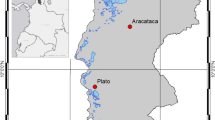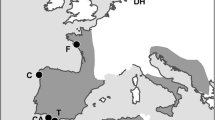Abstract
The paper brings data set of seed reproduction of about 500 wild herbaceous species of Central Europe and presents a number of produced seeds in a new way. Number of seeds — reproductive capacity of a population (RCP) was defined as a number of seeds produced by one species per 1 m2 at its one-hundred-per-cent cover per one season. About 23% of seed weight variability and about 26% of variability in RCP were explainable on a family level. The trade-off between RCP and seed weight was confirmed both within families and also among families. Both characteristics had higher variability on a family level and on lower taxonomic levels than on subclass and class levels. Species with an annual life cycle have a larger number of seeds than perennials. Geophytes and species without lateral spread have a tendency to produce a large amount of relatively weighty seeds in comparison to other life forms, and to species with vegetative lateral spread. Species with seeds dispersed by wind usually have a large number of lightweight seeds. Multivariate analyses confirmed some tendencies of reproductive traits which correspond to the definition of C-, S-, R- strategies by Grime — “verification” of the RCP as ecological trait. The R- strategy was well distinguished from the C- and S- strategies by reproductive traits, whereas C- and S- strategies are very similar to each other. Species with insect pollination agent often correspond to C- strategy, wind agent to S- strategy, and species with self-pollination to R- strategy.
Similar content being viewed by others

References
Årgen J. &Willson M.F. (1992): Determination of seed production inGeranium maculatum.Oecologia 92: 177–182.
Årgen J. &Willson M.F. (1994): Cost of seed production in the herbsGeranium maculatum andG. sylvaticum: an experimental field study.Oikos 70: 35–42.
Baker H.G. (1972): Seed weight in relation to environmental conditions in California.Ecology 53: 997–1010.
Begon M., Harper J.L. &Townsend C.R. (1990):Ecology: individuals, populations and communities. Blackwell Scientific Publications, London.
Boyd M., Silvertown J. &Tucker C. (1990): Population ecology of heterostyle and homostylePrimula vulgaris: growth, survival and reproduction in field populations.J. Ecol. 78: 799–813.
Caswell H. (1985): The evolutionary demography of clonal reproduction. In:Jackson J.B.C., Buss L.W. &Cook R.E. (eds.),Population biology and evolution of clonal organisms, Yale University Press, New Haven, pp. 187–224.
Cavers P.B. &Steele M.G. (1984): Patterns of change in seed weight over time on individual plants.Amer. Naturalist 124: 324–335.
Colosi J.C. &Cavers P.B. (1984): Pollination affects percent biomass allocated to reproduction inSilene vulgaris (bladder champion).Amer. Naturalist 124: 299–306.
Dostál J. (1989):Nová květena ČSSR 1, 2 (New flora of the CSSR). Academia, Praha.
Downs C. &McQuilkin W.E. (1944): Seed production of Southern Appalachian oaks.J. Forest. 42: 786–790.
Eriksson O. (1997): Clonal life histories and evolution of seed recruitment. In:de Kroon H. &van Groenendael J. (eds.),The ecology and evolution of clonal plants, Backhuys Publishers, Leiden, pp. 211–226.
Fenner M. (1985):Seed ecology. Chapman and Hall, London.
Frank D. &Klotz S. (1988):Biologisch-ökologische Daten zur Flora der DDR, MLU, Halle-Wittenberg.
Frankland B. (1975): Phytochrome control of seed germination in relation to the light environment. In:Smith H. (ed.),Light and plant development, Butterworth, London, pp. 477–502.
Galen C. &Stanton M.L. (1991): Consequences of emergence phenology for reproductive success inRanunculus adoneus (Ranunculaceae).Amer. J. Bot. 78: 978–988.
Grime J.P. (1977): Evidence for the existence of three primary strategies in plants and its relevance to ecological and evolutionary theory.Amer. Naturalist 111: 1169–1194.
Grime J.P. (2001):Plant strategies, vegetation processes, and ecosystem properties. Wiley & Sons, Chichester.
Grime J.P., Hodgson J.G. &Hunt R. (1987):Comparative plant ecology. A functional approach to common British species. Unwin Hyman, London.
Harper J.L. (1977):Population biology of plants. Academic Press, London.
Harper J.L., Lovell P.H. &Moore K.G. (1970): The shapes and sizes of seeds.Annual Rev. Ecol. Syst. 1: 327–356.
Hendrix S.D. (1984): Variation in seed weight and its effects on germination inPastinaca sativa L. (Umbeliferae).Amer. J. Bot. 71: 795–802.
Hejný S. &Slavík B. (eds.) (1988):Květena České socialistické republiky (Flora of the Czech Republic) 1. Academia, Praha.
Hejný S. &Slavík B. (eds.) (1990):Květena České republiky (Flora of the Czech Republic) 2. Academia, Praha.
Hejný S. &Slavík B. (eds.) (1992):Květena České republiky (Flora of the Czech Republic) 3. Academia, Praha.
Hendry G.A.F. &Grime J.P. (eds.) (1993):Methods in comparative plant ecology. A laboratory manual. Chapman and Hall, London.
Jordano P. (1995): Frugivore-mediated selection on fruit and seed size: birds and St. Lucieff’s cherry,Prunus mahaleb.Ecology 76: 2627–2639.
Judd W.S., Campbell Ch.S., Kellog E.A. &Stevens P.F. (1999):Plant systematics — a phylogenetic approach. Sinauer Associates, Sunderland.
Kawano S. (1981): Trade-off relationships between some reproductive characteristics in plants with spetial reference to life history strategy.Bot. Mag. Tokyo 94: 285–294.
Klimeš L. &Klimešová J. (1999a): CLO-PLA2 — a database of clonal plants in central Europe.Pl. Ecol. 141: 9–19.
Klimeš L. & Klimešová J. (1999b):Database of clonal plants. http://www.butbn.cas.cz/klimes (March 2002).
Kubát K. et al. (eds.) (2002):Klíč ke květeně České republiky (Key to the flora of the Czech Republic). Academia, Praha.
Lalonde R.G. &Roitberg B.D. (1989): Resource limitation and offspring size and number trade-offs inCirsium arvense (Asteraceae).Amer. J. Bot. 76: 1107–1113.
Lloyd D.G. (1987): Selection of offspring size at independence and other size-versus-number strategies.Amer. Naturalist 129: 800–817.
Lord J., Westoby M. &Leishman M.R. (1995): Seed size and phylogeny in six temperate floras: constraints, niche conservatism and adaptation.Amer. Naturalist 146: 349–364.
Lovett Doust J. (1980): A comparative study of life history and resource allocation in selectedUmbelliferae.Biol. J. Linn. Soc. 13: 189–154.
Marhold K. &Hindák F. (eds.) (1998):Zoznam nižších a vyšších rastlín Slovenska (Checklist of non-vascular plants of Slovakia). Veda, Bratislava.
Mazer S.J. (1989): Ecological, taxonomic and life history correlates of seed mass among Indiana dune angiosperms.Ecol. Monogr. 59: 153–175.
Mogie M. &Hutchings M.J. (1990): Phylogeny, ontogeny and clonal growth in vascular plants. In:Groenendael J. &de Kroon H. (eds.),Clonal growth in plants, SPB Academic Publishing, Hague, pp. 3–22.
Peat H.J. &Fitter A.H. (1994): Comparative analysis of ecological characteristics of British angiosperms.Biol. Rev. 69: 95–115.
Pijl L. (1982):Principles of dispersal in higher plants. Berlin Heidelberg, New York.
Proctor H.C. &Harder L.D. (1994): Pollen load, capsule weight, and seed production in three orchid species.Canad. J. Bot. 72: 249–255.
Renner S.S. &Ricklefs R.E. (1995): Dioecy and its correlates in the flowering plants.Amer. J. Bot. 82: 596–606.
Rothmaler W., Jäger E., Schubert R. &Werner K. (1987):Exkursionsflora für die Gebiete der DDR und der BRD. Atlas der Gefäßpflanzen. Volk und Wissen Volkseigener Verlag, Berlin.
Salisbury E.J. (1942):The reproductive capacity per plants. Bell and Sons, London.
Silvertown J.W. (1981): Seed size, lifespan and germination date as co-adapted features of plant life history.Amer. Naturalist 118: 860–864.
Silvertown J.W. &Lovett Doust J.L. (1993):Introduction to plant population biology. Blackwell Scientific Publications, Oxford.
Slavík B. (ed.) (1995):Květena České republiky (Flora of the Czech Republic) 4. Academia, Praha.
Slavík B. (ed.) (1997):Květena České republiky (Flora of the Czech Republic) 5. Academic, Praha.
Smith Ch.C. &Fretwell S.D. (1974): The optimal balance between size and number of offspring.Amer. Naturalist 108: 499–506.
Southwood T.R.E. (1988): Tactics, strategies and templets.Oikos 52:3–18.
Stanton M.L. (1984): Developmental and genetic sources of seed weight variation inRaphanus raphanistrum L. (Brassicaceae).Amer. J. Bot. 71: 1090–1098.
Statistica (1999):STATISTICA for Windows (Volume I). General conventions & statistics I (2nd Ed.). StatSoft, USA.
Sutherland S. &Vickery R.K. (1988): Trade-offs between sexual and asexual reproduction in the genusMimulus.Oecologia 76: 330–335.
ter Braak C.F.J. &Šmilauer P. (1998):CANOCO reference manual and user’s guide to Canoco for Windows: Software for canonical community ordination. Microcomputer power, Ithaca.
Thompson J.N. (1984): Variation among individual seed masses inLomatium grayi (Umbelliferae) under controlled conditions: magnitude and partitioning of variance.Ecology 65: 626–631.
Waller D.M. (1982): Factors influencing seed weight inImpatiens capensis (Balsaminaceae).Amer. J. Bot. 69: 1470–1475.
Wardlaw I.F. &Dunstone R.L. (1984): Effect of temperature on seed development in jujube (Simmondsia chinensis (Link)Schneider). 1. Dry matter changes.Austral. J. Agric. Res. 35: 685–691.
Westoby M., Leischman M. &Janice L. (1996): Comparative ecology of seed size and dispersal.Philos. Trans. Ser. B 351: 1309–318.
Wulff R.D. (1986): Seed size variation inDesmodium paniculatum. I. Factors affecting seed size.J. Ecol. 74: 87–97.
Author information
Authors and Affiliations
Corresponding author
Rights and permissions
About this article
Cite this article
Šerá, B., Šerý, M. Number and weight of seeds and reproductive strategies of herbaceous plants. Folia Geobot 39, 27–40 (2004). https://doi.org/10.1007/BF02803262
Received:
Revised:
Accepted:
Issue Date:
DOI: https://doi.org/10.1007/BF02803262



